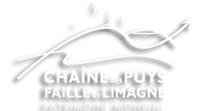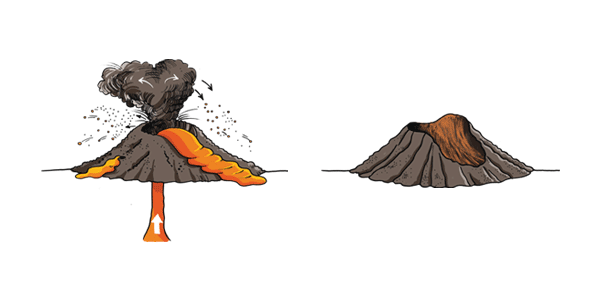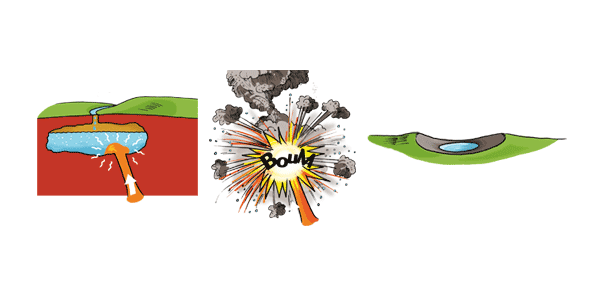The Chaîne des Puys
Age :
95,000 to 8,400 years
What is it ?
The 80 or so volcanoes which make up the volcanic alignment of the Chaîne des Puys lie on the Plateau des Dômes, parallel to the Limagne Fault. They stretch over an area 32 km long and 4 km wide.
This volcanism is also the result of continental break-up, which allowed magma to rise to the surface. Its no coincidence that the Chaîne des Puys is perfectly aligned with the Limagne Fault: the volcanoes formed along a fissure parallel to the main fault.
This was the last geological feature to appear, created between 95,000 and 8,400 years ago – the most recent being the twin volcanoes Puys de la Vache and Lassolas. The Chaîne des Puys is the youngest volcanic assemblage in mainland France. Due to the relatively young age of the volcanoes, the assemblage is termed dormant, meaning that it could become active again.
The Chaîne des Puys is mainly formed of monogenetic volcanoes (created during a single, short eruption), and constitutes an exceptional group of clearly visible and little-eroded volcanoes.
The outstanding feature of the Chaîne des Puys is its density of volcanoes, coupled with the diversity of lavas which translate into the various shapes of the puys: cones, domes and maars. The variety of these lavas is due to the evolution of the parent magma in chambers situated at different depths, opened up by the fracturing and upheaval caused by continental break-up.
Description
The Chaîne des Puys is the youngest volcanic complex on mainland France. It was formed between 95,000 and 8,400 years ago, with the most recent volcanoes being the twinned Puys de la Vache and Lassolas. Due to its geological youth, the complex is deemed to be dormant rather than extinct, meaning that a new phase of volcanism is possible.
The Chaîne des Puys is largely made up of monogenetic volcanoes (formed during a single, brief eruption), and constitutes an exceptional collection of pure volcanic landforms which have undergone very little erosion.
The uniqueness of the Chaîne des Puys lies in the density of its volcanic features, and the varied chemistry of the lavas which result in visually distinct volcanic shapes : cones, domes and maars. The chemical differentiation is due to the location of magma chambers at different depths, in which different degrees of magmatic evolution took place.
The different volcanic landforms
During an eruption magma rises up from deep in the crust. Once it reaches the surface there are various scenarios for the magma to leave the vent, depending on the quantity of gas it contains, and if there is water present at the surface. Thus the magma can be ejected up into the air, it can flow down the sides of an edifice, it can accumulate around the vent, or it can explode to form a crater if it meets a body of water.
CONE
This volcanic type, known as a Strombolian cone, is the most widespread in the world. Within the Chaîne des Puys there are numerous cones, in general between 100 and 200 m in height. The highest is the Puy de Côme, with a height of 300 m.
During the eruption, fluid lava is ejected up into the air from the vent, and it then falls vertically to accumulate around the vent in the form of ash and scoria to build up a cone. The Puy Pariou and Puy de Goules are the best representatives of almost perfectly round cones.
Under certain circumstances the volcano can erupt both scoria and lava flows at the same time. In this case the scoria are carried along by the moving lava, creating an opening in the growing cone. This is illustrated by the Puy de Louchadière, and the Puys de la Vache and Lassolas.
DOME
There are seven domes in the Chaîne des Puys, all concentrated in the central part. They formed between 15,000 and 9,200 years ago, during the last phase of volcanic activity.
During eruption the viscous lava accumulates around the vent, giving rise to a dome. Sometimes the magma can erupt explosively, triggering high-speed pyroclastic surges which move horizontally away from the vent.
This type of volcano is not associated with a crater or associated lava flows because the lava is too viscous to travel. Examples of domes are the Puy de Dôme, Puy Chopine and the Grand Sarcoui.
MAAR
There are around ten maars in the Chaîne des Puys. Maars are explosion craters which generally have a large diameter, and are now filled with lake water or sediments.
Maars form when the rising lava meets water, triggering a violent explosion. The resulting crater then fills with water or sediments. The Narse d’Espinasse has a marsh filling the crater which harbours rare, protected plants, such as the Siberian plant Ligularia.
Sometimes a new volcanic eruption can take place within a maar. This happened in the Maar de Beaunit, which has been partially infilled by products from a later-stage cone.
The influence of volcanism on relief
The site makes it easy to see how the volcanism has modified the pre-existing plateau topography: the volcanoes seem to be set down on this vast flat plateau, and individual flows can easily be picked out, such as those from the Puy de Côme and Puy de Louchadière.
Lake Aydat and Lake Cassière are the best examples of relief which has been modified through volcanism: the long lava flow originating from the Puy de la Vache sealed off two former valleys, thus blocking the water flow and leading to the creation of these two lakes. They are known as dammed lakes.
Did you know ? The range of rock compositions can be found in the building stones used in Clermont-Ferrand, Riom and Volvic – the light-coloured stone is from domes, while the darker stone is taken from the more fluid cone lavas.












